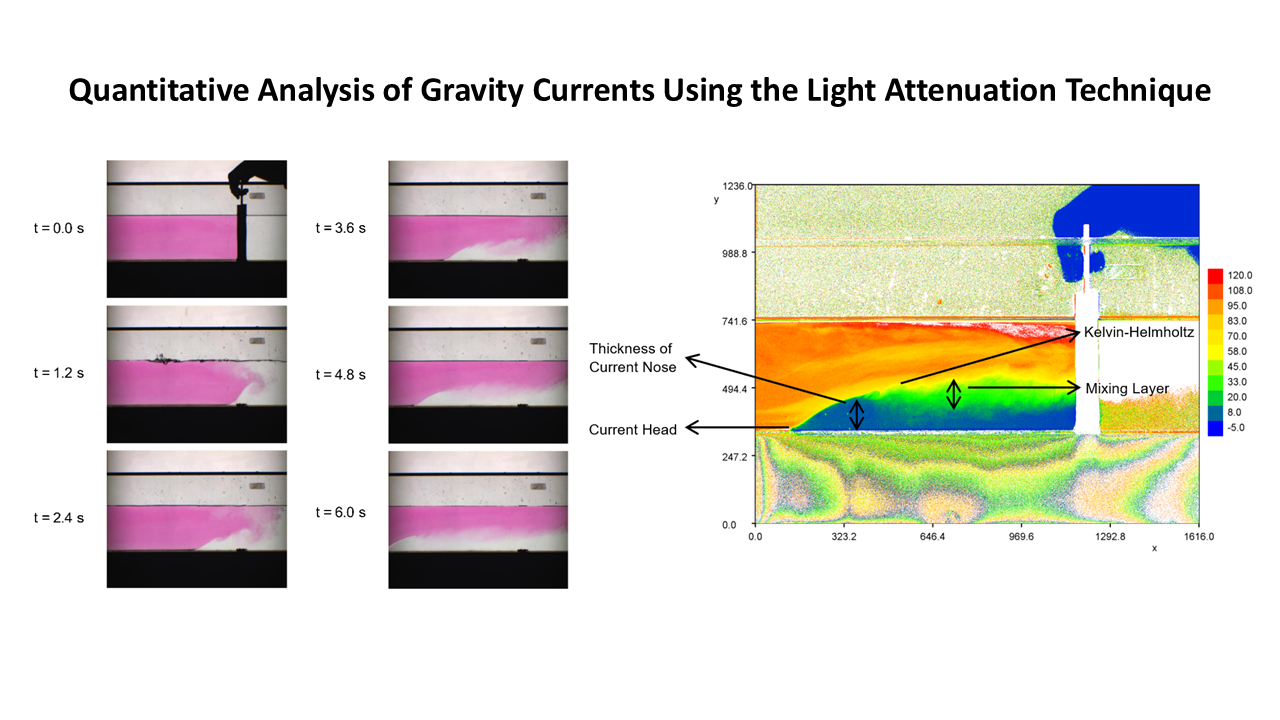Quantitative Analysis of Gravity Currents Using the Light Attenuation Technique

Downloads
It is well known that when two fluids with different specific densities are put adjacent to each other, there is an unbalanced horizontal density gradient that results in the adjustment process to achieve equilibrium, so that the less dense fluid finds its way atop the denser fluid. The purpose of this study is to employ light attenuation technique to obtain quantitative data in investigating the mentioned phenomenon. Specifically, the gravity current experiment models what is commonly found in estuaries, where there is an unbalanced density gradient due to the different densities of saltwater and fresh water. The use of light attenuation technique enables a more accurate quantitative data collection and thus enables a more rigorous definition of the location of the nose and the thickness of the head to be applied during the analysis of experimental data. It also allows for investigating the mixing characteristics of the two fluids in the highly turbulent layer immediately behind the current head process such as the velocity and the thickness of the shear layer
Allgayer, D. M., & Hunt, G. R. (2012), On the Application of the Light-Attenuation Technique as a Tool for Non-Intrusive Buoyancy Measurements. Experimental Thermal and Fluid Science, 38, 257–261.
Armi, L. (1986), The Hydraulics of Two Flowing Layers with Different Densities. Journal of Fluid Mechanics, 163, 27–58.
Benjamin, T. B. (1968), Gravity Currents and Related Phenomena. Journal of Fluid Mechanics, 31, 209–248.
Britter, R. E., & Simpson, J. E. (1978), Experiments on the Dynamics of a Gravity Current Head. Journal of Fluid Mechanics, 88(2), pp. 223-240.
Dalziel, S. B. (1991), Two-Layer Hydraulics: a Functional Approach. Journal of Fluid Mechanics, 223, 135–163.
Garcia, M. H. & J. D. Parsons (1996), Mixing at the Front of Gravity Currents. Dyn. Atmos. Oce., 24, 197–205.
Huppert, H. E. (2006), Gravity Currents: a Personal Perspective. Journal of Fluid Mechanics, 554, 299–322.
von Karman, T. (1940), The Engineer Grapples with Nonlinear Problems. Bulletin of the American Mathematical Society, 46(8), 615–683.
Kikkert, G. A. (2006), Buoyant Jets with Two and Three-Dimensional Trajectories, Doctoral Dissertation, University of Canterbury.
Klemp, J. B., Rotunno, R., & Skamarock, W. C. (1994), On the Dynamics of Gravity Currents in a Channel. Journal of Fluid Mechanics, 269, 169–198.
Kneller, B. C., Bennett, S. J., & McCaffrey, W. D. (1999), Velocity Structure, Turbulence and Fluid Stresses in Experimental Gravity Currents.Journal of Geophysical Research: Oceans, 104(C3), 5381–5391.
Kokkinos, A., & Prinos, P. (2022), Numerical Experiments of Partial-Depth Colliding Gravity Currents Using LES Environmental Fluid Mechanics, 22, (5), 1081–1105.
Moodie, T. B. (2002), Gravity Currents. Journal of Computational and Applied Mathematics, 144(1-2), pp. 49-83.
Necker, F., C. Härtel, L. Kleiser, and E. Meiburg (2005), Mixing and Dissipation in Particle Driven Gravity Currents. Journal of Fluid Mechanics, 545, pp. 339-372.
Nokes, R. I. (2005), "ImageStream Version 4.01." Christchurch, Image Processing Software.
Prastowo, T. (2009), On the Nature of Gravity Currents. Jurnal Matematika Dan Sains (Journal of Mathematics and Science), 14(3), pp. 76-80.
Shin, J. O., S. B. Dalziel, & P. F. Linden (2004), Gravity Currents Produced by Lock Exchange. Journal of Fluid Mechanics, 521, pp. 1-34.
Simpson, J. E. (1997), Gravity Currents in the Environment and the Laboratory, 2nd ed., Cambridge University Press, Cambridge, UK.
Simpson, J. E. (1982), Gravity Currents in the Laboratory, Atmosphere, and Ocean. Annual Review of Fluid Mechanics, 14(1), pp. 213-234.
Simpson, J. E., & Britter, R. E. (1979), The Dynamics of the Head of a Gravity Current Advancing over a Horizontal Surface. Journal of Fluid Mechanics, 94(3), pp. 477-495.
Viola, S., Chen, Z., Yao, A. M., Valyrakis, M., Kelly, A. E., McKee, D., & Lavery, M. P. (2020), Degradation of light carrying orbital angular momentum by ballistic scattering. Physical Review Research, 2(3), pp. 033093-1 to 033093-7.
Copyright (c) 2025 Journal of Engineering and Technological Sciences

This work is licensed under a Creative Commons Attribution-NonCommercial-NoDerivatives 4.0 International License.












